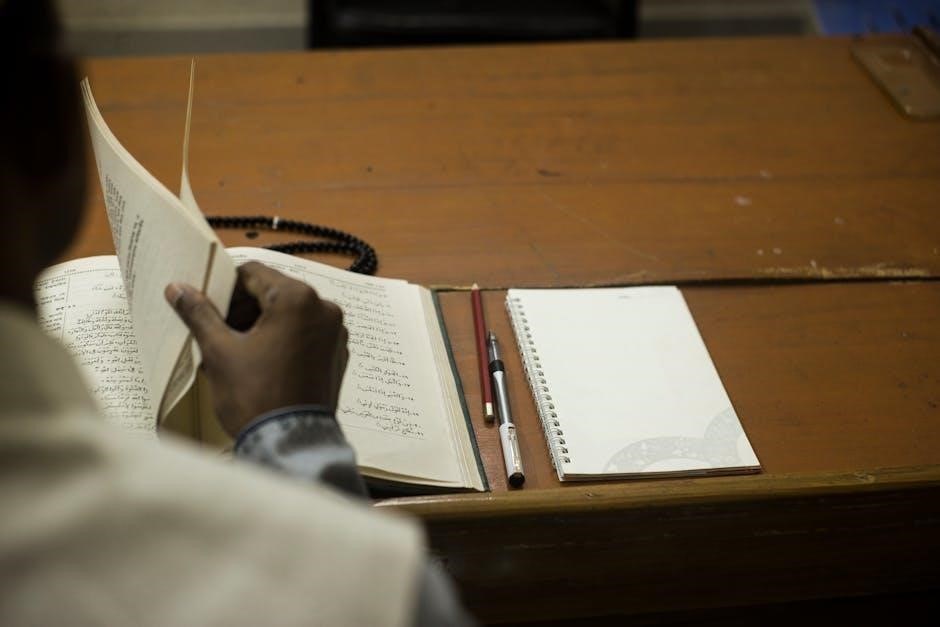
Anne Frank’s diary is a poignant historical document offering insights into life under Nazi occupation. Available as a free PDF, it remains a vital educational resource, providing emotional depth and enduring legacy.
1.1 Background on Anne Frank and Her Historical Significance
Anne Frank was a young Jewish girl born in Germany in 1929, whose family fled to Amsterdam to escape rising anti-Semitism. She began writing her diary in 1942, documenting life in hiding during the Nazi occupation. The diary captures her hopes, fears, and daily struggles, offering a deeply personal perspective on one of history’s darkest periods. Anne’s story has become a symbol of resilience and humanity, resonating globally. Her diary, now available in PDF formats, serves as a vital educational tool, preserving her legacy and providing insight into the Holocaust’s impact on individuals and families. Anne’s life and writings continue to inspire reflection and empathy worldwide.
1.2 The Diary as a Historical Document of World War II
Anne Frank’s diary is a powerful historical document of World War II, offering a unique perspective on life under Nazi occupation. It details the daily struggles, hopes, and fears of a young girl in hiding, providing an intimate account of the Holocaust’s impact on individuals. The diary’s authenticity and emotional depth make it a crucial resource for understanding the human experience during this period. Available in PDF formats, it allows readers to engage with this historical text digitally, ensuring its accessibility for future generations. The diary’s historical significance lies in its ability to personalize the broader atrocities of the war, making it an essential tool for education and remembrance.

1.3 The Global Impact of Anne Frank’s Story
Anne Frank’s diary has had a profound global impact, transcending time and borders. Its availability in PDF format has made it accessible worldwide, ensuring its message of hope and resilience reaches millions. The diary is widely studied in schools, serving as a powerful tool for Holocaust education and fostering tolerance and understanding. Its emotional depth resonates universally, making it a cornerstone of human rights discussions. The story has inspired numerous adaptations, further amplifying its reach. Today, Anne Frank’s legacy continues to unite people across cultures, reminding them of the importance of empathy and the dangers of prejudice. Her words remain a timeless call for humanity and peace.

The Diary of a Young Girl: Key Themes and Content
Anne Frank’s diary reveals her life in hiding, detailing daily struggles, emotional depth, and hope. It captures the human spirit during wartime, offering a poignant, personal narrative of resilience and survival.
2.1 The Life of Anne Frank Before Hiding

Anne Frank was born in Frankfurt, Germany, in 1929, to a Jewish family. Her early life was marked by joy and normalcy, despite rising anti-Semitism. In 1933, the Frank family moved to Amsterdam to escape Nazi persecution. Anne grew into a lively, curious girl, excelling in school and cherishing friendships. Her father, Otto, established a successful business, providing stability for the family. Anne’s life took a dramatic turn in 1940 when the Nazis invaded the Netherlands, imposing harsh restrictions on Jews. By 1942, the family realized hiding was their only hope for survival. Anne’s diary, begun just before they went into hiding, captures her hopes, fears, and resilience during this tumultuous period.
2.2 The Secret Annex: A Detailed Description
The Secret Annex, located above Otto Frank’s office in Amsterdam, was a hidden space where Anne Frank and her family lived in hiding. The annex consisted of three floors, with the main living area on the top floor. It was accessed through a movable bookcase in the office building. The space was cramped, with limited natural light and basic amenities. Anne shared the annex with her parents, sister Margot, and four others. The diary vividly describes the annex’s layout, including the rooms, furnishings, and daily life. This hidden world became their refuge from Nazi persecution, preserved in Anne’s detailed writings, now widely available in PDF formats.
2.3 The Daily Life and Struggles in Hiding
Anne Frank’s diary vividly captures the daily life and struggles of living in hiding. The Secret Annex, cramped and poorly ventilated, was home to eight people, including Anne and her family. They relied on others for food and supplies, living in constant fear of discovery. Daily routines were rigid, with silence enforced during business hours to avoid detection. Anne’s writings reveal the emotional toll of confinement, including conflicts, boredom, and the struggle to maintain hope. Despite these challenges, Anne’s diary became her escape, where she expressed her thoughts and aspirations. The PDF versions of her diary provide a poignant window into this harrowing yet inspiring period of her life.

2.4 The Emotional and Psychological Depth of the Diary
Anne Frank’s diary offers profound emotional and psychological insights into her experience. It captures her growth from a young girl to a deeply reflective individual, grappling with hope, fear, and identity. The diary reveals her inner world, showcasing her struggles with confinement, family dynamics, and the uncertainty of their fate. Anne’s writings express universal themes of adolescence, such as self-discovery and longing for understanding, set against the backdrop of war. Her emotional depth and resilience shine through, making the diary a powerful exploration of the human spirit. The PDF versions of her diary preserve these intimate reflections, allowing readers to connect with her journey on a deeply personal level.
The PDF Version of Anne Frank’s Diary
Anne Frank’s diary is widely available as a free PDF, offering readers access to her poignant reflections. Popular editions include translations and adaptations, ensuring global accessibility and historical preservation.
3.1 Availability of Free PDF Copies Online
Free PDF copies of Anne Frank’s diary are widely available online, offering easy access to her historic account. Platforms like Reddit, Internet Archive, and Z-Library provide downloadable versions, enabling global readers to explore her story. These PDFs are often accompanied by translations, making the diary accessible in multiple languages. The availability of free digital versions ensures that Anne Frank’s experiences reach a broad audience, fostering education and reflection on World War II history. This accessibility has made her diary a vital resource for students, researchers, and anyone seeking to understand the Holocaust’s personal impact.
3.2 Popular Editions and Translations of the Diary in PDF
Anne Frank’s diary is available in various popular editions and translations as PDFs, ensuring global accessibility. The “Diary of a Young Girl” retold by Cherry Gilchrist is a widely downloaded version, offering a concise narrative. Additionally, the Oxford Bookworms edition by Rachel Bladon provides an adapted version for educational purposes. Translations into multiple languages, including Dutch and English, have broadened the diary’s reach. These PDF editions are often free, making them a valuable resource for students and readers worldwide. The availability of diverse editions ensures that Anne Frank’s story remains accessible and engaging for different audiences, preserving its historical and emotional significance.
3.3 The Importance of Preserving the Diary in Digital Format
Preserving Anne Frank’s diary in digital formats ensures its accessibility for future generations. PDF versions, available through platforms like Internet Archive and Z-Library, safeguard the diary from physical degradation. Digital preservation also facilitates global distribution, allowing readers worldwide to engage with Anne’s story. This format supports educational initiatives, enabling schools and researchers to incorporate the diary into Holocaust studies. Moreover, digital copies protect the original text from loss, ensuring its historical integrity. The diary’s digital presence fosters a deeper understanding of its significance, promoting tolerance and awareness. By maintaining Anne Frank’s legacy in digital form, her story remains a vital tool for education and reflection.

The Cold Case Investigation and Betrayal Theories
A cold case team investigated Anne Frank’s betrayal, proposing Arnold van den Bergh as a suspect, sparking debates and controversies over their findings and conclusions.
4.1 The Mystery of Who Betrayed Anne Frank
The betrayal of Anne Frank remains one of World War II’s most enduring mysteries. A cold case investigation suggested Arnold van den Bergh, a Jewish notary, might have revealed the Frank family’s hiding place to the Nazis. This theory, while widely debated, has sparked significant controversy among historians and the public. The investigation relied on extensive research, including archival documents and testimonies, but critics argue the evidence is circumstantial. Despite the findings, the exact identity of the betrayer may never be fully confirmed, leaving the case shrouded in uncertainty. The debate continues to highlight the complexities of wartime loyalties and betrayals.
4.2 The Cold Case Team’s Investigation and Findings
A cold case team conducted an extensive investigation into Anne Frank’s betrayal, analyzing historical records and testimonies. They proposed Arnold van den Bergh as a suspect, suggesting he might have revealed the Frank family’s hiding place. The team’s findings were based on meticulous research, including previously overlooked documents. However, their conclusions have faced criticism from historians, who argue the evidence is not definitive. The investigation aimed to provide closure but instead sparked debate, underscoring the challenges of resolving historical mysteries. Despite the controversy, the team’s work has contributed to a deeper understanding of the circumstances surrounding Anne Frank’s arrest.
4.3 Controversies Surrounding the Betrayal Theories
Theories about Anne Frank’s betrayal have sparked intense debate, particularly after a book claimed Arnold van den Bergh was the likely informant. Critics argue the evidence is circumstantial, and the book’s recall has fueled controversy. Historians question the reliability of the cold case team’s conclusions, emphasizing the lack of definitive proof. Jewish communities have expressed outrage, calling the accusations against van den Bergh baseless and harmful. The debate highlights the sensitivity of assigning blame for such a tragic event. While some seek closure, others argue the focus should remain on Anne’s legacy rather than unproven theories, ensuring her story continues to educate and inspire future generations.
The Book “The Betrayal of Anne Frank”
The book explores the cold case investigation into Anne Frank’s betrayal, sparking controversy. Its claims and recall have fueled debates about historical accuracy and ethical publishing.
5.1 Overview of the Book and Its Claims
The book “The Betrayal of Anne Frank” delves into the mystery of who revealed her hiding place to the Nazis. It presents a detailed investigation by a cold case team, suggesting Arnold van den Bergh as a potential suspect. The book’s claims sparked significant controversy, with historians and the Jewish community questioning its conclusions. Despite its recall, the book reignited debates about the betrayal, offering new perspectives on one of WWII’s most enduring mysteries. Its publication highlighted the complexities of historical truth and the ethical challenges of revisiting such sensitive events. The book’s impact continues to be felt in discussions about Anne Frank’s legacy.
5.2 The Identification of Arnold van den Bergh as a Suspect
The cold case investigation identified Arnold van den Bergh, a Jewish notary, as a potential suspect in betraying Anne Frank. The team suggested he might have revealed the secret annex’s location to the Nazis, possibly to save his own family. This claim was based on extensive research, including historical records and interviews. However, the theory faced criticism from historians and Jewish communities, who argued the evidence was circumstantial and damaged van den Bergh’s legacy. The book’s recall followed these controversies, highlighting the ethical dilemmas of accusing someone decades after the events. The identification of van den Bergh sparked debates about justice, guilt, and historical accountability.
5.3 The Book’s Recall and Public Reaction
The book implicating Arnold van den Bergh in Anne Frank’s betrayal sparked intense public reaction. Critics accused the authors of relying on circumstantial evidence, leading to its recall. Jewish communities expressed outrage, arguing it unfairly tarnished van den Bergh’s memory. The recall highlighted the challenges of solving historical mysteries and the ethical responsibility of making such accusations. Public debate centered on balancing historical truth with respect for the accused and their families. The controversy underscored the sensitivity of Holocaust-related research and the need for rigorous evidence in such cases. The recall also raised questions about the impact of such claims on the legacy of victims and their families.

Educational and Cultural Significance of the Diary
Anne Frank’s diary serves as a powerful tool for Holocaust education, fostering tolerance and understanding. Its adaptations in various media ensure its cultural relevance and global impact.
6.1 The Diary as a Tool for Holocaust Education
Anne Frank’s diary is a powerful educational resource for understanding the Holocaust. Its personal and emotional account makes the atrocities relatable, helping students grasp the human impact of WWII. The diary, available as a free PDF, is widely used in classrooms to teach tolerance and empathy. It highlights themes of hope, resilience, and the loss of innocence, providing a unique perspective on Jewish persecution. Educators use the diary to foster critical thinking about historical events, promoting a deeper understanding of the Holocaust’s significance. Its accessibility in multiple languages ensures global reach, making it an indispensable tool for Holocaust education and remembrance.
6.2 The Role of the Diary in Promoting Tolerance and Understanding
Anne Frank’s diary serves as a powerful tool for fostering tolerance and understanding by sharing her personal experiences during the Holocaust. The diary’s emotional depth and universal themes resonate globally, encouraging readers to reflect on prejudice and human rights. By detailing her hopes, fears, and resilience, Anne’s story bridges cultural and generational gaps, promoting empathy and compassion. The diary’s accessibility in PDF format ensures its message reaches a wide audience, inspiring dialogue about tolerance and the importance of standing against discrimination. Its impact lies in its ability to humanize history, making the lessons of the past relevant for future generations.

6.3 Adaptations and Interpretations of the Diary in Various Media
Anne Frank’s diary has been adapted into various forms of media, including films, plays, and educational resources. The PDF version of her diary is widely used in classrooms, making it accessible for students to study her experiences. Additionally, the diary has inspired numerous literary and cinematic interpretations, ensuring its message reaches diverse audiences. A recent book, The Betrayal of Anne Frank, sparked controversy by identifying a potential betrayer, leading to its recall. These adaptations highlight the diary’s enduring relevance and its ability to provoke reflection on historical events. They also underscore the importance of handling sensitive content responsibly to preserve its educational and emotional impact.
Legal and Ethical Considerations
The diary’s copyright issues and ethical debates over its publication highlight the challenges of balancing historical preservation with personal privacy rights, ensuring responsible handling of sensitive content.
7.1 Copyright Issues and Access to the Diary

The diary’s copyright has been a subject of debate, with its expiration in 2016 in the EU sparking discussions about free access. While many seek to share Anne Frank’s story widely, publishers and estates often control distribution. Free PDF versions are available online, but their legality varies by region. The diary’s global popularity has led to numerous editions and translations, ensuring its accessibility. However, ethical concerns arise over modifications to the original text. Balancing historical preservation with copyright laws remains a challenge, emphasizing the need for responsible handling of such sensitive and significant historical documents.
7.2 Ethical Debates Over the Publication of Personal Diaries
The publication of Anne Frank’s diary raises ethical questions about privacy and consent. While her writings are invaluable for historical education, they were deeply personal. Critics argue that publishing such intimate content without the author’s consent, even posthumously, crosses ethical boundaries. Supporters counter that her story serves a greater purpose in combating prejudice and educating future generations. The balance between preserving history and respecting personal privacy remains a contentious issue, particularly as digital formats like PDFs make the diary widely accessible. These debates highlight the complexity of sharing personal narratives for public benefit while honoring the individual’s rights.
7.3 The Responsibility of Publishers in Handling Sensitive Historical Content
Publishers handling Anne Frank’s diary in PDF formats face significant ethical responsibilities. They must ensure accuracy, context, and respect for the author’s legacy. The diary’s sensitive nature requires careful editing to maintain its historical integrity while avoiding exploitation. Publishers are also tasked with addressing copyright issues and ensuring proper attribution. Additionally, they must balance accessibility with ethical considerations, particularly when digitizing such a deeply personal and historically significant work. The global impact of the diary underscores the importance of responsible publishing practices to preserve its educational value and emotional depth. By doing so, publishers honor Anne Frank’s story and its enduring relevance to humanity.
Anne Frank’s diary remains a timeless testament to resilience and humanity, offering invaluable insights into history. Its digital preservation ensures future generations can learn from her story and legacy.
8.1 The Enduring Legacy of Anne Frank’s Diary
Anne Frank’s diary has left an indelible mark on history, offering a deeply personal account of life under Nazi occupation. Its availability in PDF format ensures global accessibility, making it a vital educational tool for understanding the Holocaust. The diary’s emotional and psychological depth continues to resonate, fostering empathy and tolerance. It has become a cornerstone of Holocaust education, prompting reflections on humanity and resilience. The cold case investigation and debates over betrayal theories highlight its ongoing relevance. Despite controversies, the diary remains a powerful symbol of hope and the human spirit, ensuring Anne Frank’s voice endures for future generations to learn from and cherish.
8.2 The Importance of Preserving Historical Truth
Preserving historical truth is essential for understanding the past and preventing future atrocities. Anne Frank’s diary, available as a PDF, serves as a firsthand account of the Holocaust, offering an unfiltered perspective on life under Nazi rule. Its digital preservation ensures that future generations can access this vital historical document, fostering education and remembrance. The diary’s authenticity underscores the importance of protecting such records from distortion or loss. By maintaining the integrity of Anne Frank’s story, we honor the victims of the Holocaust and promote a truthful understanding of this dark chapter in human history, ensuring its lessons are never forgotten.
8.3 The Ongoing Relevance of Anne Frank’s Story in Modern Times
Anne Frank’s story remains deeply relevant today, offering timeless lessons on humanity, tolerance, and resilience. Her diary, widely available as a PDF, continues to educate millions about the Holocaust, fostering empathy and understanding. In an era marked by rising discrimination and social divides, Anne’s words serve as a powerful reminder of the dangers of prejudice. The digital accessibility of her diary ensures that future generations can engage with her story, making it a vital tool for combating intolerance and promoting peace. Anne Frank’s legacy endures, inspiring global dialogue on human rights and the importance of standing against injustice in all its forms.





